The last generation Verna worked wonders for Hyundai, particularly the diesel. That was the time when diesels were hot-selling and the Verna’s 1.6-litre engine wasn’t just among the smoothest but was also the most powerful engine in its class apart from returning good efficiency. The new generation Hyundai Verna is now here and needless to say, builds on the strengths of the previous generation car. It impressed us when we drove it first at the media drive, and we now bring to you a full road test of the all-new Verna powered by the same 1.6-litre diesel engine.
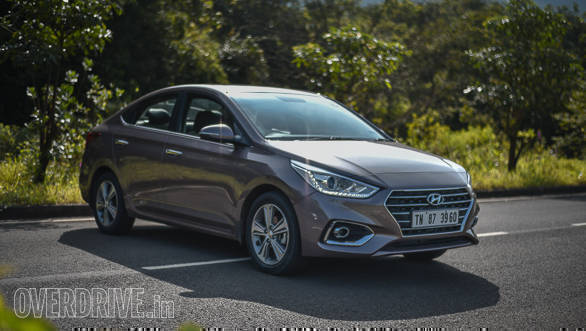 The 2017 Hyundai Verna looks a lot more European than its predecessor
The 2017 Hyundai Verna looks a lot more European than its predecessor
One of the new Verna’s biggest highlights has to be its modern and more upmarket design. Hyundai’s design team has been doing a stellar job over the years and the new Verna bears testimony to that with its chic European looks. There’s ample changes to the front end over the older car but the headlamp design is too similar, which is a bit of a disappointment to me. That said, the new shape and design of the grille and horizontal line across the car’s width for the hood opening do their bit in giving the face a sense of newness.
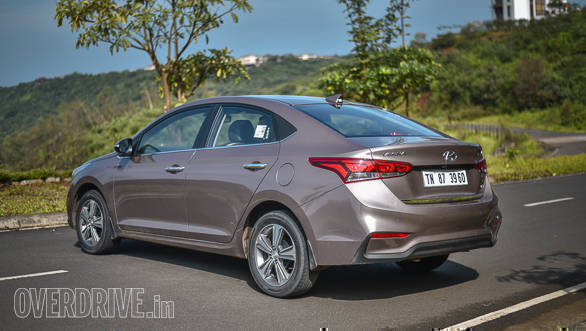 The 2017 Hyundai Verna’s rear end looks inspired from the new Elantra’s, particularly the lights
The 2017 Hyundai Verna’s rear end looks inspired from the new Elantra’s, particularly the lights
What’s also noteworthy are the projector beams for the headlights and the fog lamps. The headlights a cornering function, a boon on unlit roads. I liked the design of the rear even more, especially the way the tail lights extend into the sides. The triple LED tail lights are inspired from the Elantra’s and add a sense of dynamicness. The overall silhouette is the same as the previous Verna with a tall stance, though I would have liked a lower stance for a sportier visual effect.
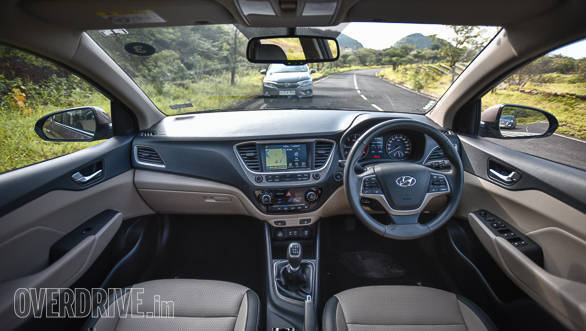 The 2017 Hyundai Verna’s cabin looks familiar
The 2017 Hyundai Verna’s cabin looks familiar
The cabin layout isn’t very different from its stablemates, but that isn’t a bad thing. Interiors are well-appointed and the placement of controls is good. The new steering controls add to the upmarket feel while offering better usability. The quality of plastics is as good as it gets and plastics are nice to the touch with a smooth feel. The 7-inch touchscreen offers a good resolution but a slightly crisper resolution would have been more welcome, particularly for the navigation. The infotainment system offers Apple CarPlay, Android Auto and MirrorLink connectivity.
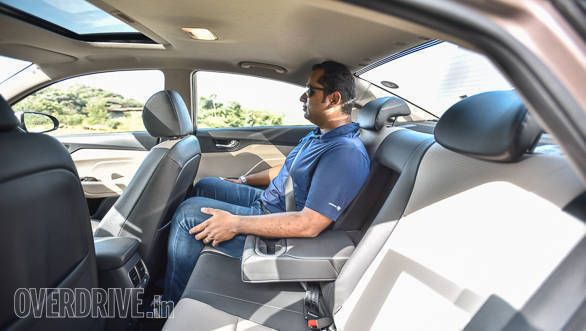 The 2017 Hyundai Verna’s rear seat is plush and comfortable but more kneeroom would have been welcome
The 2017 Hyundai Verna’s rear seat is plush and comfortable but more kneeroom would have been welcome
The ventilated seats deserve a mention as their cooling effect is a boon, and the seats are nicely cushioned and offer good bolstering. The rear bench is comfortable but leg and kneeroom aren’t as generous as some of the competition. The rear seat is a nice place to be in though with its plushness as the height of the arm rest is perfect and the rear air-conditioning vents ensure drafts of cold air reach you well. There’s an additional USB port for rear occupants, a thoughtful addition for the chaueffer driven lot. Storage spaces are abundant with several useful cubby holes, cup holders, a front central arm rest with storage and one-litre bottle holders in all doors.
Boot volume may not be best in class but there’s good amounts of space and I don’t think the average buyer will complain. Another highlight is the remote opening function for the boot, like the Elantra and Tucson – you simply need to stand behind the car for three seconds with the key in your pocket for it to open – which helps a lot when your hands are full.
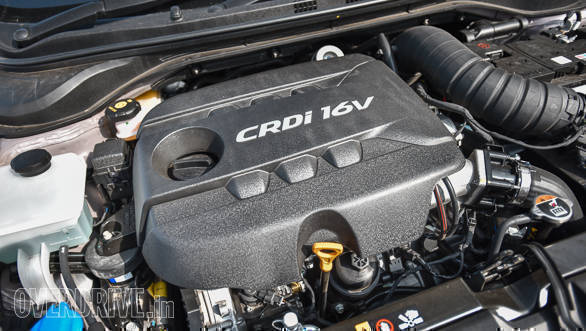 The 2017 Hyundai Verna’s 1.6-litre diesel engine is the most powerful in class, offering 128PS
The 2017 Hyundai Verna’s 1.6-litre diesel engine is the most powerful in class, offering 128PS
The 1.6-litre four cylinder diesel engine offers the same 128PS and 260Nm but tweaks have helped improve performance across the rev range. Peak torque is now available from as low as 1500rpm up to 3000rpm, as opposed to the earlier range of 1900 to 2750rpm. This is telling in the way power is sent to the wheels as the car feels eager to respond to throttle inputs. The Verna accelerated to 100kmph in 10.3 seconds in our VBOX tests, which should be the quickest in its segment given that the outputs are the highest.
There’s a strong thrust around 2500rpm and progress is in city is brisk, irrespective of what gear you are in. In-gear acceleration is quick too but that said the throttle is a little too responsive at low speeds and a milder response will reduce the jerkiness it brings in. The engine feels extremely with barely any diesel clatter at idle or too much noise at high revs. The 1.6-litre diesel engine in fact has been Hyundai’s star performer over the years and only feels better in its latest guise.
 The 2017 Hyundai Verna’s 1.6-litre diesel engine is among the smoothest in class
The 2017 Hyundai Verna’s 1.6-litre diesel engine is among the smoothest in class
The engine impresses with its efficiency too, as the new Verna returned 24.88kmpl on the highway and 14.27kmpl in city. This translates to an overall efficiency of 16.92kmpl and a tank range of over 750km given the 45-litre tank capacity. And as proved by the previous generation Verna and cars like the Creta that also use the same engine, the 1.6-litre engine is excellent in terms of reliability as well.
The new Verna is also a huge improvement in terms of ride and handling. The suspension setup is stiffer and logic dictates that the ride should thus be stiffer but that isn’t the case. The suspension isn’t crashy as before over bumps and potholes and is a lot quieter in that sense, while still soaking it all up. There are a few thuds when going fast over broken roads but on the whole the ride is a lot more settled which makes for a better in-cabin experience. Another huge improvement is stability at speeds. The older car’s softer setup caused the car to wobble at speeds, especially given the undulations on our roads but the new setup does a far better job of keeping the car planted.
Cruising at highway speeds is thus a far better experience. This should make the new car more likeable, be it for the driver or occupants. The firmer suspension helps around corners as the car feels more planted, also courtesy the grip from the 195/55 R16 Hankooks it comes shod with. Steering feel has improved with a more weighted feel at speeds and around corners but I would have liked the system to be slightly more communicative. Brakes have a progressive feel but more bite would certainly make for a more reassuring experience. On the whole the new car is a huge leap over its predecessor but still isn’t worthy of being called a driver’s car unlike some of its rivals.
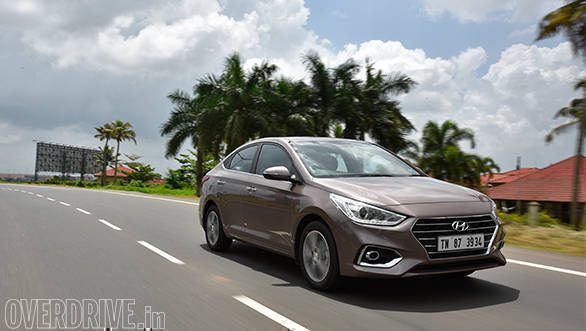 The 2017 Hyundai Verna feels a lot more planted at highway speeds than the previous version
The 2017 Hyundai Verna feels a lot more planted at highway speeds than the previous version
To sum it up, the Hyundai Verna impresses a lot in every department be it design, overall quality, performance, efficiency or ride and handling. The improvements make it more likeable as an executive sedan or family car with its more upmarket feel. Typical of Hyundais, the Verna comes loaded to the gills with features which makes it a well-engineered, thoughtfully designed car. The fact that it looks more premium than before is an added bonus, especially when you consider that introductory pricing for the first 20,000 buyers begins from Rs 7.99 lakh and goes up to Rs 12.61 lakh ex-showroom New Delhi.
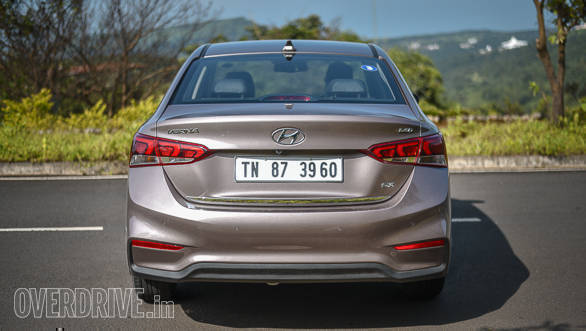 The 2017 Hyundai Verna looks more European, drives a lot better and gets more features than before
The 2017 Hyundai Verna looks more European, drives a lot better and gets more features than before
Images by Anis Shaikh
[“Source-overdrive”]





